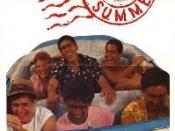"Aloha Summer"ÃÂ Shows True Aloha.
"Aloha Summer"ÃÂ, a 1988, Tommy Lee Wallace film, that defies all the stereo types that we have talked about and studied throughout this coarse.
Every Tuesday evening we gather as a class to discuss all the idiosyncrasies that we can depict from the films that we watch of the pacific. Not one week has a film failed to display a stereotypical view of the pacific as seen by Hollywood. As a class we sit and laugh, because of coarse we seem to know better the reality of how Hawaii really is, and although we have become accustomed to being stereo typed it still seems to be bothersome to the class. As I sat down to see this film "Aloha Summer"ÃÂ, I was ready for a good laugh from what I expected to see of Hollywood's view of Hawaii in the late 80's, instead I sat through the movie in awe of how well Hawaii was depicted and how it defied the code of being another laughable movie.
Aloha Summer is a film about the adventure that 6 teenagers shared on the summer of 1959. Early in this film we see a shot of Waikiki and it is very similar to what we have seen in many of the different films, we see women in bikinis and everybody on the beach is thin and appealing. We have laughed at this site many times this semester but the reality of it is that Waikiki beach is this meat market that we see in these films. When I walk through the beach of Waikiki the majority of what I see are women in bikinis and a lot of sexuality on the beach. Aloha Summer uses the women as a background and not as sexual objects, I felt that this movie was very fair to the scene in Waikiki as we see it in real life, The film shows a majority of tourist with a fair amount of locals having fun in the sun as we can witness nearly everyday if we walk through Waikiki beach.
The next stereotype that was defeated by this film was the cockiness of the foreign male over the natives. The two lead "haoles"ÃÂ in this film did not display any superiority over the natives, the two "haoles"ÃÂ sat at the same level and spoke at the same level that the natives did. The Hawaiian friends were not treated, as pity friendships to make the "haoles"ÃÂ seem sympathetic to natives so that they would get the sex appeal that Hollywood sells by making the "haole"ÃÂ man seem native. The friendship between the Hawaiian teens and the American teens was and equal understanding of two cultures, which was set in a 1959 backdrop, way ahead of its time! In this film there was a scene which mentioned how the local Hawaiian teen was very smart and "well spoken"ÃÂ then the film went on to explain why he never went to college, and it was a problem that still exist till today here in Hawaii, "Jerry"ÃÂ the local boy, was scared of leaving the islands because he had never been off of Hawaii. In explaining this, the movie also defied another stereotype that has been common in all the films we have seen, that the natives are uneducated and savage! A typical Hollywood exploitation of native women that fall in love with the foreign male has been a prominent theme of our class. Once again "Aloha Summer"ÃÂ was able to defeat that subject in keeping it fair. In all the movies we have seen we always see the haole man and a native woman, but we never get to see the foreign woman and native man. In several scenes of this movie we are see the locals boys with haole girls and the other way around, there was no emphasis on what was dominant in the interracial relationships, they all seemed to be equal. At the end of the film we see 3 bonds, first the marriage of Kelani, (a local boy) and his wife (a haole female) in the following scene we see Mike and Chucks sister pursuing a relationship (two haoles), and finally in the last scene Chuck announces the marriage between himself and Kimos sister (a local girl). "Aloha Summer"ÃÂ was fair to all the races in this aspect of the film.
I was pleased to see how the youth of 1959 were glorified on how well they got along with other cultures and were free of racism. Racism was addressed from three different cultures and each situation was resolved by the youth correcting the elder. Kenzo, the young Japanese teen corrects his father and tells him how shameful he is because of his fathers hatred towards Americans, this is a struggle that Kenzo fights throughout the film and finally is resolved when Mike saves Kenzo's life. Mike's father is racist towards all minorities and in a scene from the beginning of the film Mike tells his father what a fool he is, of coarse it wasn't until Mike's life was threatened that his father realized he needed to change. Finally we have the racism of the locals towards the Haoles, Kimo was very racist towards all the Caucasians in this film, his younger sister tells him in one of the scenes, "your so racist, you should move to Mississippi"ÃÂ unfortunately Kimo's racism gets him killed.
This 1988 film that is in a 1959 setting did a wonderful job in portraying Hawaii as it looked in 1959,I am not quite sure how it was done but the portrayal was successful. "Aloha Summer"ÃÂ was able to defy all the Hollywood tendencies to make Hawaii like a brothel and Hawaiian look like objects. With a name like "Aloha Summer"ÃÂ and the cheesy cover on the tape I was expecting to see a Bay Watch style of film but instead I was pleasantly disappointed with the results of this movie. I am amazed that there are no preview to be found on this film, they show the movie for sell but say nothing, is this because of the justice that was done to Hawaii by this film?




